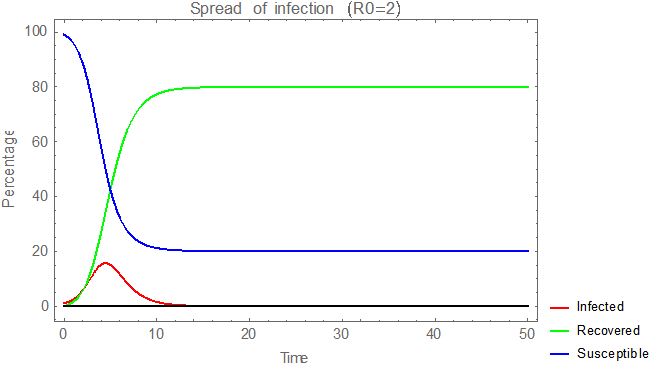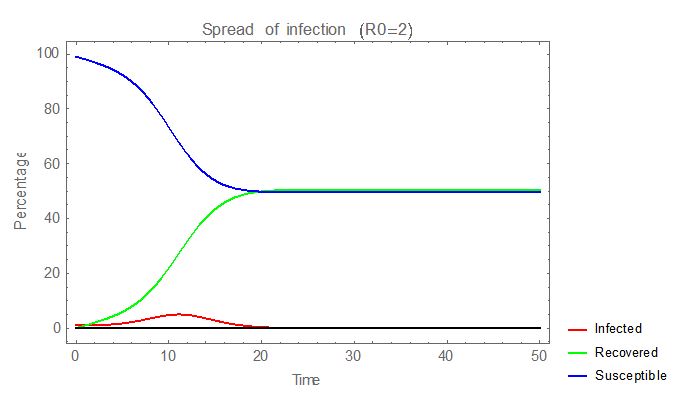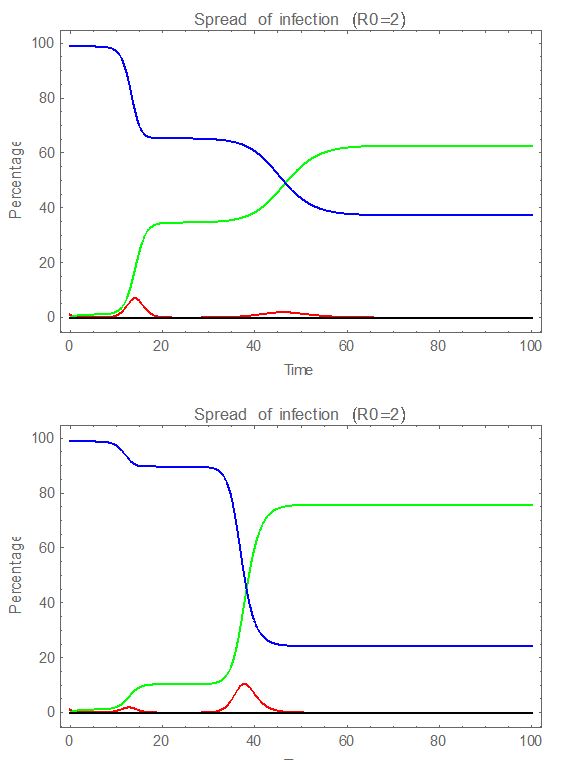This is a post by Simon Anthony, a one-time theoretical physicist. Congratulations are due to Simon, as he has had an article published in The Critic, Britain’s hottest new magazine. Recently two regular contributors here (if you can call me that) have been published in The Critic, so if you fancy yourself as a writer, this is clearly the place to cut your teeth. Submission information here (it doesn’t have to be a technical article on Covid. It could be, say, an historical article on the origins of the dressing gown. Or whether the flute is superior to the clarinet, either in music or in hand-to-hand combat.)
The effect of lockdown on the spread of C-19 has been, to put it mildly, hotly debated. Many contributions to this debate have been misinformed, misleading and disingenuous, based on a weak understanding of how infectious diseases spread. In this piece I’ll try to clear up some of those misconceptions, particularly how they affect lockdown and its aftermath.
1: As many people die after lockdown as would have died if there hadn’t been a lockdown
This is incorrect. If the disease spreads at all before lockdown, the eventual mortality following lifting of the lockdown is lower than it would be without lockdown. This is a picture from a model of the spread of a disease with an R0 (number of people infected by each infected person) of two in which no lockdown is imposed. There’s a single peak in the number of infections and a stable point is reached when ~80% of the population has been infected and ‘removed’ so they’re no longer susceptible – they’ve either recovered or died.

Here’s the same model, same R0, but with a period of lockdown imposed shortly after the infection appears.

Where there was originally a single larger peak, now there are two peaks, the first at the initial outbreak separated by the lockdown period after which there’s a second peak.
In the this case, a stable state is reached with ~70% of the population having been infected.
This is an example of a general result: a lockdown period reduces the final number of infections (and hence mortality).
2: For a given R0, herd immunity occurs when a particular fraction of people have been infected
This is untrue. Obviously, item 1 above shows this not to be the case. Two different scenarios led to stable final situations with different numbers of people having been infected and recovered. In the no-lockdown case ~80% of people were infected while under lockdown only ~70% of people were infected.
The reason this happens – that more people are eventually infected when the infection is allowed to run unchecked – is that the peak of infections is much higher so that, even when the number of infections start to fall, there are still so many infected people that the infection overshoots its optimal level. More people are infected than is strictly needed for herd immunity.
The optimal fraction of the population to be infected so as to give herd immunity in an SIR model is (1 – 1/R0). In the case when R0 is 2, optimal herd immunity requires 50% of the population to be infected. Any greater fraction doesn’t improve herd immunity but does kill more people than “necessary” to achieve herd immunity.
In both examples above, more than 50% of people were infected. Is there some way to infect only the optimum number and minimise the death toll while reaching herd immunity?
Here’s an example in which herd immunity is reached at ~50%, the optimum level:

In this case the lockdown is gradually decreased, effectively increasing R0 slowly enough so that the number of infected people at any time is never large enough to allow overshoot. In practice it’s obviously very difficult to control R0 in such a way: you can’t be sure what its value is at any time and relatively small changes can lead to very different outcomes. Nonetheless, as a general principle, gradually reducing lockdown is likely to lead to fewer infections (and consequent deaths) than removing it in one step.
The reason why the optimum value for herd immunity occurs with the number of infected people equal to (1 – 1/R0) is explained in my earlier post on “Covid-19: Myths, misunderstandings and omissions”. In item 3 of that post, I showed that the number of new infections stops increasing when S/P = 1/R0, that is, when the susceptible fraction of the population is equal to 1/R0. But, once the situation has stabilised, if the susceptible fraction at that time is 1/R0, then the remainder – those people who’ve been infected by the disease and recovered – is (1 – 1/R0).
3: The second peak after lockdown will be bigger than the first
This is sometimes true and sometimes not. By adjusting the timing and duration of lockdown, the relative sizes of pre- and post-lockdown peaks can be changed. Here are examples, both for R0 = 2, the first with a higher pre-lockdown peak, the second with a higher post-lockdown peak.

The difference is that the lockdown in the second case was imposed sooner than in the first case, so the initial peak wasn’t as high, leaving a greater number of infections for the post lockdown period.
Whether we’re currently in a situation like the first or the second of these cases is hard to know but it might be possible to make some deductions using the available test data.

10 thoughts on “Simon Anthony: Covid-19 and Lockdown: Myths, misunderstandings and omissions”
Thank you.
It would be very useful for the country as a whole if Boris or a scientist or doctor we trust could explain the slow unlocking approach which looks as though it’s the governments plan.
“Slower, but safer” is a good message to have.
Another excellent exploration of the parameter space. Perhaps a final look would compare with a situation where part of the population has immunity (although it will tend to look like post release from lockdown scenarios), but it might help explain the Diamond Princess and Theodore Roosevelt cases, and offer some hope for the more general prognosis.
One point which I never see discussed is the development of an effective treatment for Covid – which is a new disease with some specific features.
I suspect that some of the early treatments for severe Covid may have made the condition worse. They were based on the assumption that this was an influenza-like disease. Intubation, in particular, seems no longer to be indicated. And there are no end of clinical tests of various drugs going around.
The advantage of slowing the infection rate of a new disease is that it stops limited health services being overwhelmed, but it also gives time for an optimum treatment to be developed and distributed. It is unlikely that we can lockdown severely for the length of time a vaccine needs to be developed, but if a pre-existing medicine like hydroxychloroquine is determined to be of value, the total mortality rate could be lowered greatly.
There is also the point that a better treatment regime, associated with a lower death rate, would encourage people to return to normal life more rapidly…
“This is an example of a general result: a lockdown period reduces the final number of infections (and hence mortality).”
Hmm. If we take it to its logical conclusion, and a 100% effective lockdown is imposed before the epidemic takes off and is in place for long enough and is then released, a ‘stable state’ will be reached with 0% of the population infected. This doesn’t mean, however, that you have achieved herd immunity; it means you have physically snuffed out the virus.
If you release the lockdown and get an infected visitor, you are back to square one, with a completely susceptible population and the same number of deaths as you would have had without the lockdown period. So is the statement above true? I suggest it is only true if you add the condition that no infected people can return at a later date.
Sorry but this is just far too simplistic. It assumes there is equal probability of each member of a given population if infected , dies. We know that this is just not true. So for instance if the over 70s were fully locked down for the entire period with absolutely no contact ( impossible in reality) the infection could be left to rip through the rest of the population with little chance of a significant death rate, whatever the R0.
In the real world IF the care homes were not infected and general hospital wards not infected, it would be reasonable to protect the over 70s with comorbidities as much as they wanted and raise the lockdown immediately in full for everyone else. The deaths would then escalate very little with herd immunity reached quickly. Unfortunately because of incompetence, the deaths in hospital wards and care homes will continue whatever is done about lockdown. But that is not a reason to delay lifting it in full.
I sincerely hope BoJo et al are not receiving this sort of advice without the correct provisos, perhaps my faith in their intelligence is misplaced.
@Simon Anthony
Maybe it does, but is it mostly – as Ferguson said – those who’d have died in next 9 months anyway?
Is the reduced mortality now worth the £2.4 Billion cost per day to UK – ~£10 Million per delayed death? imo No
Your first point is obviously correct: if part of a population is perfectly protected from infection, they won’t be infected. It’s also true that the remaining population will reach herd immunity if the infection spreads among them (actually excess HI if the infection is “let rip”). It’s also true that if the protected people were randomly distributed among the immune population, you’d have solved the problem – HI would be “shared” with the previously protected community.
Unfortunately, there are two problems. First, during the protected period the infection would still reach the vulnerable because they rely on the rest of the world to support them so the infection is inevitably transferred. It may not be deliberately “let rip” but even under current LD, many care homes become infected with very high mortality.
The second problem occurs when the protection is removed. Herd immunity will only be shared if the previously protected people are randomly distributed among the HI population. Otherwise, the enclaves of vulnerable people, for example in care homes, will be just as prone to infection as they were originally as the care homes have no HI within them. Eventual mortality will be very similar to what would have occurred without any protection.
You’re obviously correct in that if you have 100% of the population isolated from contact, no more people will be infected and when LD is released, you’re back where you started.
But 100% LD isn’t being proposed. The goal of LD is to create an environment in which the rate of spread of infection is reduced. With anything less than 100% LD, infection will spread at some rate. At 0% LD, the number of infections will rise quickly and overshoot the numbers needed for HI. So medical facilities may be overwhelmed and more people will die (as more have been infected) than would have done if HI hadn’t been exceeded.
LD slows the growth of infections so that medical facilities can cope and the number of infected people overshoots by as few as possible so as to reduce the eventual mortality rate.
The underlying point is that, without a vaccine, HI will sooner or later be reached. The aim is to do so within the limits of medical capacity while minimising the excess (above HI) mortality. It may be that Sweden has found a form of soft LD which is doing just this.
All true, but I was just homing in on your general statement about lockdown resulting in fewer deaths, whereas many people think it is just stretching things out (the ‘myth’). I gave an example where your general statement appeared to be obviously true, but could also be seen as not true in a special case: where an infected person arrived after the epidemic seemed to be over.
As I see it, the lockdown does two things: it temporarily prevents or slows down transmission (reduces ‘R’), but it also results in some of the infection within the population ‘disappearing’. It is the latter effect that produces the reduction in deaths that you are observing.
In my extreme example (but still valid), it all disappears. So if we apply a 100% lockdown for a month, ‘R’ drops to zero, and the virus is completely gone when we release it. But ‘R’ then resumes at exactly the same value it was before the lockdown was applied – it’s just that there’s no virus any more.
So you are obviously right: it has resulted in fewer deaths. But is that the end of the story? What if an infected person from outside comes for a visit?
The upshot is that I think your statement is true if the population is enclosed and sealed. It is not necessarily true if the infection still exists in the outside world and can visit your population later. The extreme 100%, 1 month lockdown example is still a valid case for your general statement, and is my way of getting my head around it!
How revealing: Mr Anthony ignores the difficult question whilst answering another
Simon Anthony Friday 8th May 2020 at 10:15 says:
– – – Crickets
Comments are closed.